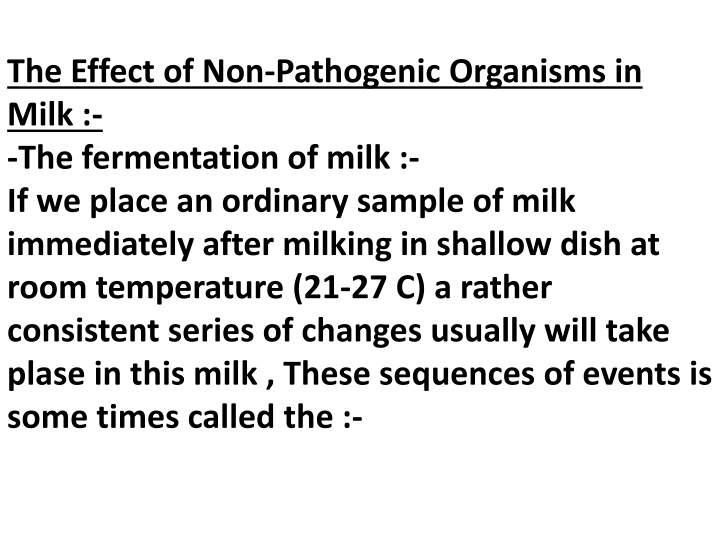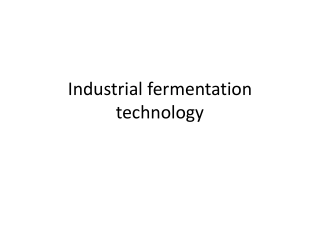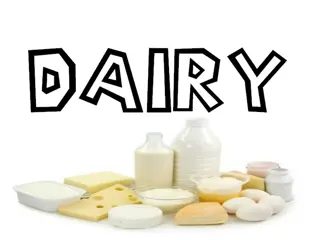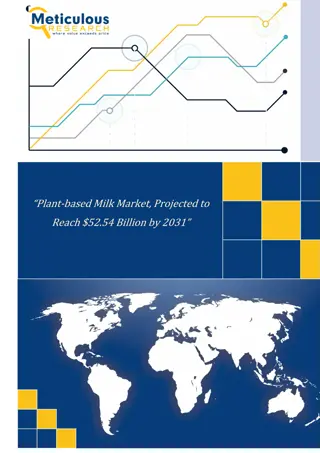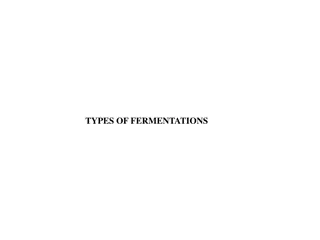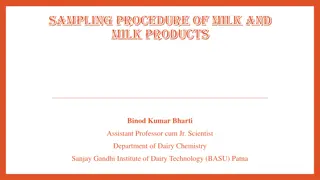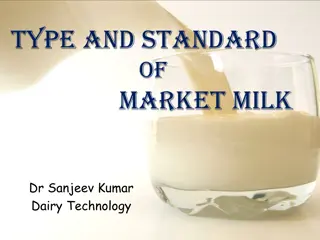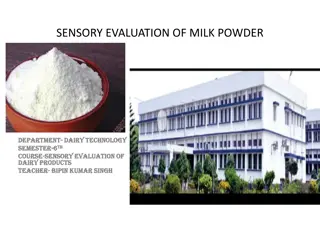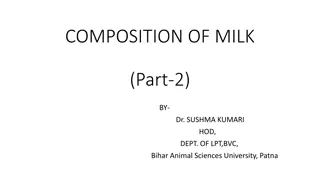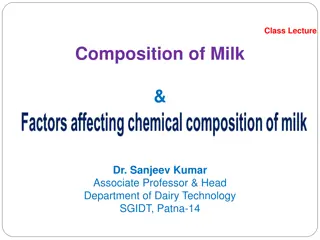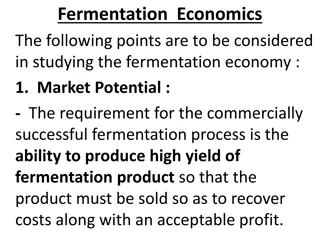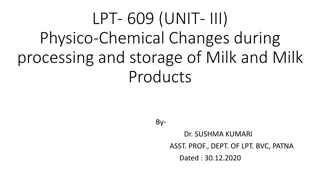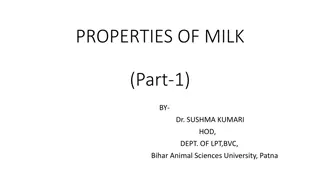Milk Fermentation and Pathogenic Organisms
The fermentation process of milk undergoes several phases involving non-pathogenic and pathogenic organisms. Normal fermentation includes phases like germicidal, souring, neutralization, and putrefactive, while pathogenic organisms can lead to abnormal changes like carbohydrate degradation, acid fermentation, and more. Pathogens can contaminate milk, leading to milk-borne diseases. Various types of organisms can infect intestines through ingestion, causing symptoms of poisoning. Major diseases of animal origin include Brucellosis, Bovine Tuberculosis, Salmonellosis, Q-Fever, and Campylobacteriosis.
Download Presentation

Please find below an Image/Link to download the presentation.
The content on the website is provided AS IS for your information and personal use only. It may not be sold, licensed, or shared on other websites without obtaining consent from the author.If you encounter any issues during the download, it is possible that the publisher has removed the file from their server.
You are allowed to download the files provided on this website for personal or commercial use, subject to the condition that they are used lawfully. All files are the property of their respective owners.
The content on the website is provided AS IS for your information and personal use only. It may not be sold, licensed, or shared on other websites without obtaining consent from the author.
E N D
Presentation Transcript
The Effect of Non-Pathogenic Organisms in Milk :- -The fermentation of milk :- If we place an ordinary sample of milk immediately after milking in shallow dish at room temperature (21-27 C) a rather consistent series of changes usually will take plase in this milk , These sequences of events is some times called the :-
-Normal fermentation of milk :- It may be divided into four phase as follows :- 1-Germicidal phase (Antimicrobial systems in milk ) . 2-Souring phase (Growth of Lactic acid bacteria) . 3-Neutralization phase (Growth of yeast & molds). 4-Putrefactive phase (Decomposing bacterial flora).
The Effect of Pathogenic Organisms in Milk :- -Abnormal Changes (Taints) in milk :- 1-Carbohydrate Degradation 2-Acid & Gas Fermentation 3-Lipolysis 4-Proteolysis 5-Sweet Curdling 6-Ropy (slimy) milk 7-Alkali Production 8-Alcohol Fermentaion 9-Flavor Changes 10-Colored Changes
8- Pathogenic of Raw Milk (2 h.) Milk-Borne Diseases :- Infections , Intoxications & Toxi-infections . Contamination of food with pathogenic m.o.s. & growth & multiplication of this m.o.s in that food will lead to infection to the consumer (Salmonellosis) . While growth & multiplication of m.o.s. in the food & production of toxin in this food , this is called (Food intoxicatin) & the toxion affecting the gastro-intestinal tract are called (Enterotoxins).
There are yet other types of organisms which can infect intestine when ingested alone with the food & produce toxins in sites to bring about symptoms of poisoning , this situation is called (Toxi-infection). The pathogenic organism may be introduced into milk from :- 1-Dairy animals (Cows). 2-Milk handlers . 3-Environment .
-Major Diseases of Animal Origin:- 1.Brucellosis (Br.abortus,Br.melitensis) 2.Bovine Tuberculosis (Mycobacterium bovis) 3.Salmonellosis 4.Q-Fever (Coxiela burnetii Rickettsia) 5.Campylobacteriosis (C.jejuni,C.fetus,C.coli)
-Occasinal Diseases of Animal Origin: - 1.Leptospirosis (L.canicola,L.hardjo,L.pomona) 2.Listeriosis (L.monocytogenes) 3.Yersiniosis (Y.pseudotuberculosis,Y.enterocolitica) 4.Anthrax (Bacillus anthracis) 5.(Streptococcus agalactiae) infection 6.Foot&Mouth disease (Aphthovirus,Picornaviridae) 7.Cow pox (Cow pox virus) 8.Rabies (Rhabdovirus)
-Fungal Diseases:- Actinomycosis (A.bovis)
-Bacterial Diseases of Human Origin: - 1.Typhoid Fever (Salmonella typhi) 2.Paratyphoid Fever (Salmonella paratyphi) 3.Cholera (Vibrio cholera) 4.Dysentery Shigellosis 5.Diphtheria (Corynebacterium diphtheriae) 6.Septic Sore Throat & Scarlet fever (Streptococcus pyogenes) 7.Staphylococcul Enterotoxaemia 8.Human Tuberculosis (Mycobacterium hominis
-Viral Diseases of Human Origin :- 1.Poliomyelitis (Poliovirus (RNA) 2.Viral Hepatitis (Enterovirus) a-Hepatitis A virus(HAV) b-Hepatitis B virus(HBV) c-Hepatitis C virus(HCV) d-Hepatitis D virus(HDV) e-Hepatitis E virus(HEV) g-Hepatitis G virus(HGV)
